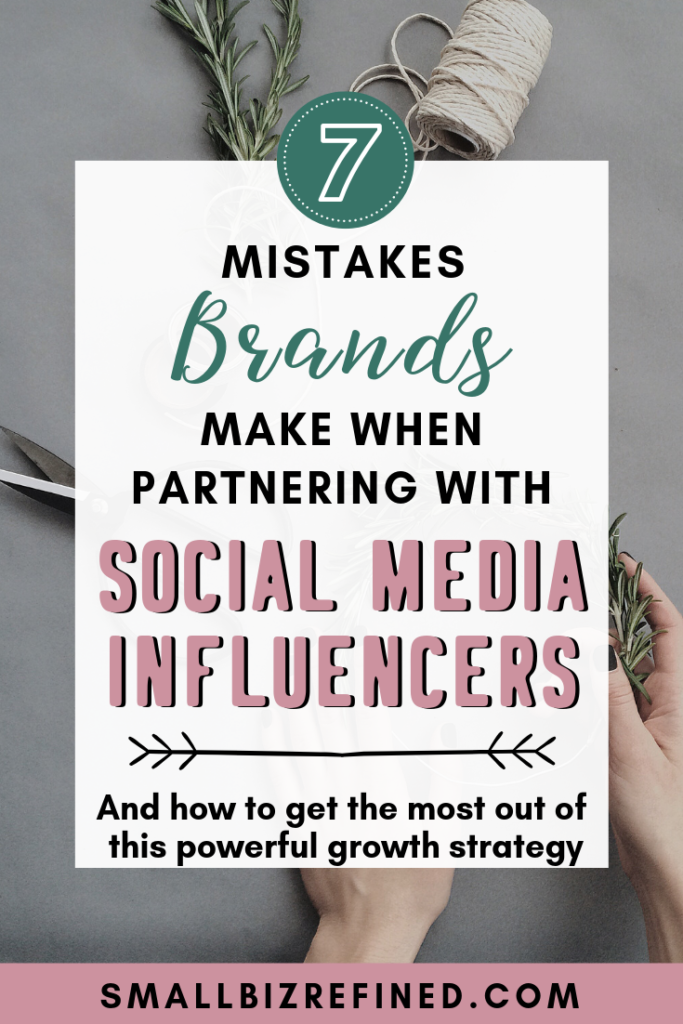For small businesses, influencer marketing on Instagram can amplify exposure to large audiences (and bring in more traffic and sales). In fact, it’s one of the best strategies I used when I owned an online bookshop.
Having a mini-tribe of influencers gushing over your brand and products sounds pretty sweet, doesn’t it?
But there are some common mistakes brands make with influencers. Before you jump into a partnership blind, you should be aware of them. That way, you can make sure you get the most out of this powerful strategy!
First, if you’ve never heard the term social media influencer (also known as brand representative), or if you want to know more about how the strategy works, read my post on how to use brand reps to grow your business on Instagram.
Enter your email below to get the brand rep templates I use myself sent straight to your inbox!
Basically, you form a mutual agreement with an influencer on social media. They’ll promote your business, and in exchange, you send them free products. Not only does this expose your brand to a much larger audience, but it also boosts your social proof and trust factor.
It can save you so much time on social media outreach, and provide you with awesome photos & content to share on your own account.
Plus, it’s so much fun to connect with people who love your products!
But it takes some trial & error to get the most out of it.
So, to help you avoid wasting time or money, here are 7 common mistakes brands make with influencer marketing on Instagram.

Influencer Marketing on Instagram: Mistakes to Avoid
1. Only Looking at Follower Count
When deciding which influencers to partner with, follower count is not the most important metric.
Engagement rate, activity level, and photo quality are more important factors to consider.
Instagram Engagement Rate
If the influencer has a ton of followers, but none of them are liking or commenting on her posts, those followers probably aren’t even reading her posts. Which means they won’t be seeing what they post about your brand. That’s not going to help anyone!
In fact, some users even purchase fake followers. A very low engagement rate is a good sign of this. Try to avoid these influencers.
Here’s an easy way to calculate engagement rate: divide the number of followers by the average number of comments on the user’s most recent 10-20 posts. For reference, the average Instagram engagement rate is about 3%.
Activity Level
You want to partner with someone who’s active on the platform, and who interacts with her followers. Does she typically reply to her posts’ comments? Does she ask questions in her posts’ captions to spark conversations? Is she actively posting Instagram stories or videos?
These are all essential qualities of an ideal influencer for your brand. The more engaging and active they are, the more their followers will read and trust what they say about your products.
Photography Quality
One of the best things about partnering with influencers is the influx of gorgeous photos and quality content they create about your products. It’s so easy to share this content with your own followers. That’s why one of my deciding factors is photo quality.
Different influencers have different aesthetics. That’s what makes them stand out from the crowd. So I don’t expect bright white photos from everyone.
What I care about (and what you should, too) is that their pictures are high-resolution, have good composition, and maybe use interesting props or backgrounds. The minimalist look is also great for showing off products.
The more an influencer’s pictures stand out and attract other users, the more exposure your brand and products will get.
2. Choosing Influencers Who Aren’t in Your Niche
Just because an influencer has 10,000 followers doesn’t mean they’re the right person to partner with.
Let’s say you sell nursery decor. If an influencer has never shown an interest in children or home decor, it’s unlikely that many of her followers would care about those things either. If that’s the case, you probably won’t see much return on your investment.
Focus on influencers who are passionate about your brand’s niche and message. People who care about those things will flock to that influencer, and then they’ll happily stumble upon you.
3. Ignoring Your Stats
Be sure to keep track of your numbers. That’s how you’ll know if this strategy is working for you, or if you need to tweak something.
Write down your follower count and engagement rate before and after each brand rep term. Also make sure to note the number of customers and the average number of orders you receive.
For example, if your partnership term lasts 2 months, track what numbers you’re at before you started and when it’s over. That gives you a metric to compare how much your account and business has grown.
If you use Etsy, Shopify, or another platform that allows you to give discount codes (and if you choose to give your reps a code for their followers), you can easily analyze how often these codes are used per each individual influencer.
Ultimately, getting more sales should be one of your top goals, and tracking your numbers will tell you if your partnerships are worthwhile.
4. Not Setting Clear Expectations
You need to have a clear set of expectations or instructions for influencers to follow. Be specific, and tell them upfront before they agree to anything.
How often are you expecting them to post about your products? Are they expected to mention you in their account’s bio?
I always include my expectations upfront when I first post my brand rep search. Then, after I’ve chosen who to partner with, I send them an email prior to the rep term with everything they might need to know.
Be sure to mention what they’ll get in return (typically free products). This is a mutual partnership, after all!
5. Not Tracking & Following Up
If you’ve set clear expectations but someone isn’t sticking to them, you need to have a conversation with them. I’m not saying you should confront them, though.
Try reiterating what you hoped the partnership would be, then give them a chance to explain why they haven’t been holding up their end of the bargain.
Many times, miscommunication or a life event are the culprit. If they seem genuine, I recommend giving them a second chance. You never want to burn bridges if you don’t have to!
6. Not Keeping in Touch With Influencers
It’s essential to stay in touch with your partners throughout the process. Even if you don’t have any updates, just sending a friendly check-in message (or having a casual, non-business related conversation) can go a long way.
The partnership may go so well that you want to extend it. Having a good relationship with the influencer makes it more likely they’ll want to work with you again.
Remember: you’re the face of your brand, so it’s important to be professional. But there’s nothing wrong with getting to know your brand reps on a personal level. In fact, I strongly encourage it!
7. Tweaking Your Influencer Marketing Program
The longer you work with influencers, the more you’ll see what works best for YOUR business in particular. Maybe certain products do better with certain types of influencers or audiences.
Every couple of months, take a look at everything you’ve learned. See if you need to tweak your program, your expectations, or the types of influencers you work with.
Now that you’re prepared to dip your toes into influencer marketing on Instagram (without any costly mistakes), it’s time to make it happen! Download the tips & templates below to save yourself some hassle.


Thanks so much for these important tips! ☺